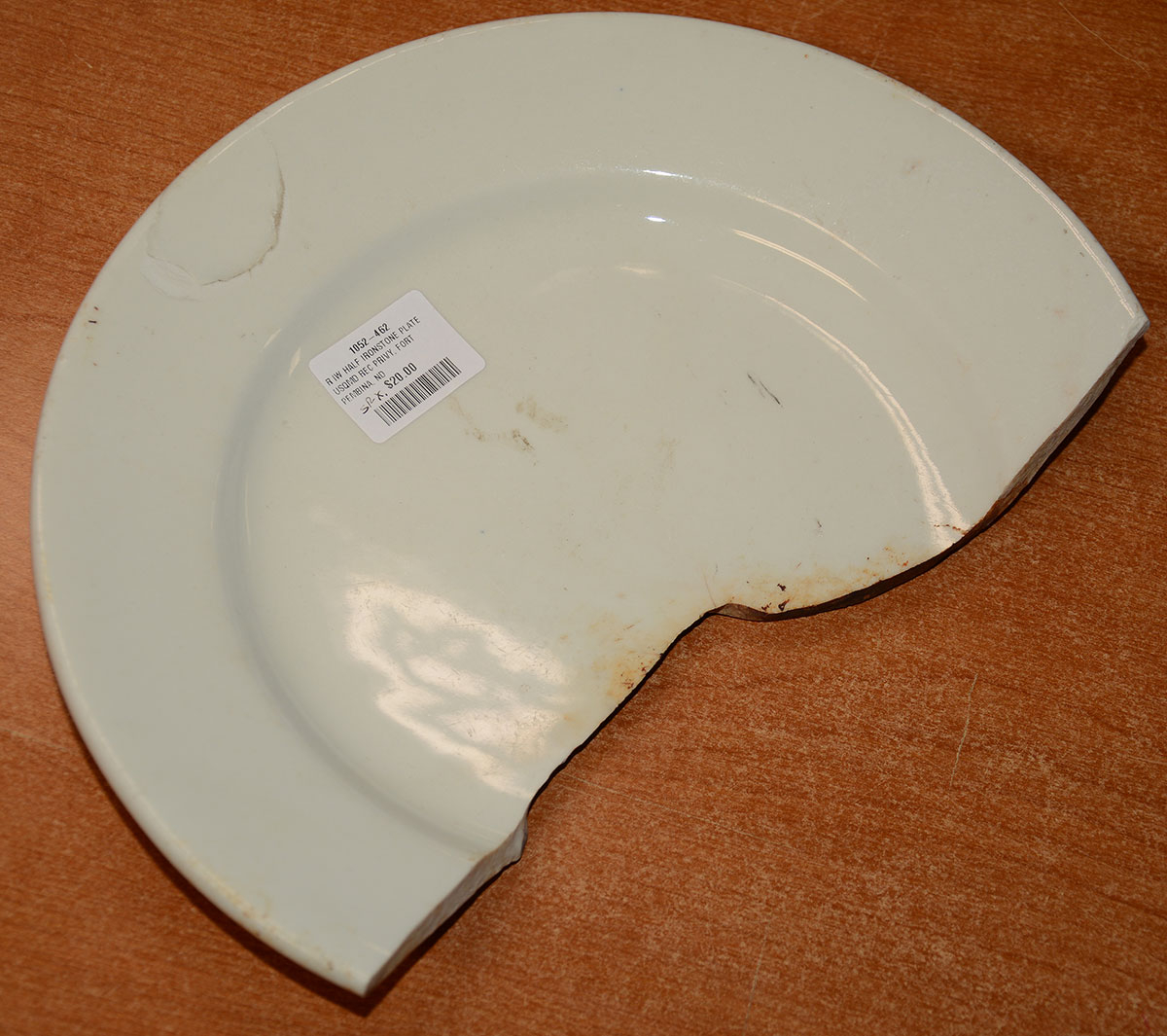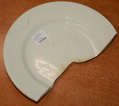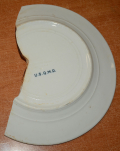site search
online catalog
US QUARTERMASTER DEPT MARKED PLATE FROM FORT PEMBINA

$20.00 SOLD
Quantity Available: None
Item Code: 1052-462
This broken ironstone china plate is stamped on the back by the Greenwood China Company of Trenton, N.J., and also clearly stamped in blue “U.S.Q.M.D.” indicating it was army property issued through the U.S. Quartermaster Department. This comes from the excavations at Fort Pembina, ND, a small U.S. army fort in operation from 1870 to 1895. The Greenwood company operated from 1890 to about 1929, and in 1901 were billed as making “hotel china” and “chinaware.” Even if not the highest grade of tableware for fine dining, it at least shows it wasn’t all tin plates and mess cups at the fort, at least in its later days.
The plate is missing about 1/3 and we see a secondary surface crack on one side near the edge. The break is a clean break with edge showing some brown staining. The surface is good and the marking very clear, though missing part of the “G” in Greenwood. This was excavated at Fort Pembina, North Dakota, on private property with the owner’s permission. The fort was situated in the Red River Valley in North Dakota near the Canadian border. Trading posts existed earlier in the area as part of the fur trade, and the first U.S. military post there was temporary- manned by a detachment of Minnesota troops in 1863-1864 following the 1862 Sioux uprising. In March 1870 a new fort was established south of the Pembina River and about 200 yards west of the Red River, completed by July and named in honor of Gen. George H. Thomas. The name was changed to Fort Pembina in September and the initial garrison consisted of two companies of the 20th US Infantry. As was typical of the army at this period, the troops were uniformed and equipped from government stocks left over from the Civil War. Only in 1872 did patterns start to change and even then the army made an effort to use up old material to save expense and storage space.
The main purpose of the fort was to provide security for settlers worried about Sioux returning south from Canada, but much of their duty involved escorting boundary surveys along the Canadian border and preventing Fenian raids heading north into Canada. The post included enlistedmen’s barracks, officers’ quarters, guard house, ordnance storehouse, company kitchen, root house, laundress’s quarters, quarters for civilian employees, hospital and hospital servant’s house, a barn for the “hospital cow,” quartermaster and commissary offices and storehouse, stables, wagon shed, etc. The garrison reached peak strength in 1878 of 200, but the average was about 125 enlisted men and 8 officers. An October 1885 return listed 97 men, 2 field pieces, 1 mountain howitzer, 100 rifles, 19 pistols, 23 mules, and 9 wagons. By 1890 the post had just 23 men, and after an 1895 fire destroyed some 19 buildings it was decided to abandon the fort rather than rebuild. The last detachment left in September, the property was turned over to the Interior Department, and later sold in 1902.
This is an interesting relic that would fit in a display illustrating daily life at these garrisons, which were remote, but liked to keep up appearances. [sr] [ph:L]
~~~~~~~~~~~~~~~~~~~~~~~~~~~~~~~~~~~
THIS ITEM, AS WITH ALL OTHER ITEMS AVAILABLE ON OUR WEB SITE,
MAY BE PURCHASED THROUGH OUR LAYAWAY PROGRAM.
CLICK HERE FOR OUR POLICIES AND TERMS.
THANK YOU!
Inquire About US QUARTERMASTER DEPT MARKED PLATE FROM FORT PEMBINA
For inquiries, please email us at [email protected]
Most Popular
Historical Firearms Stolen From The National Civil War Museum In Harrisburg, Pa »
Theft From Gravesite Of Gen. John Reynolds »
Cavalry Carbine Sling Swivel »
Fine Condition Brass Infantry Bugle Insignia »
featured item
VERY SCARCE 1799-1800 SWAN CONTRACT VIRGINIA MILITIA REGIMENTALLY MARKED MUSKET: 42nd REGIMENT, PITTSYLVANIA
This musket is stamped “42. VA. REGT. PITTSYLVANIA” on the barrel, was later altered to percussion and then shortened for use in the civilian market. It is a scarce survivor from muskets delivered to Virginia by Jame Swan of Boston in January… (1000-241). Learn More »






